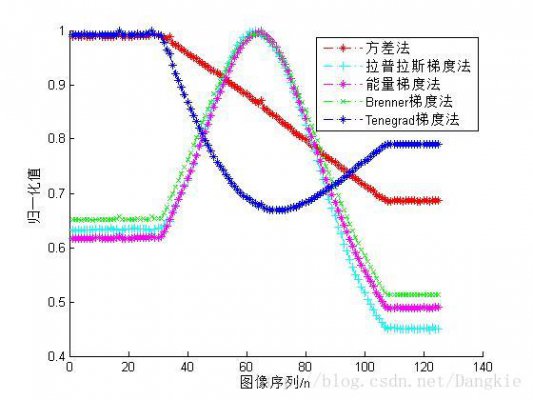图像清晰度评价
最近在搞自动对焦,对比了若干种方法后,发现已有前人做过,而且做得比我好,转过来分享给大家
原文链接 http://makaidong.com/dangkie/1/462485_9325093.html
图像清晰度是衡量图像质量的一个重要指标,对于相机来说,其一般工作在无参考图像的模式下,所以在拍照时需要进行对焦的控制。对焦不准确,图像就会变得比较模糊不清晰。相机对焦时通过一些清晰度评判指标,控制镜头与CCD的距离,使图像成像清晰。一般对焦时有一个调整的过程,图像从模糊到清晰,再到模糊,确定清晰度峰值,再最终到达最清晰的位置。
常见的图像清晰度评价一般都是基于梯度的方法,本文将介绍五种简单的评价指标,分别是Brenner梯度法、Tenegrad梯度法、laplace梯度法、方差法、能量梯度法。
Brenner梯度法
计算相差两个单元的两个像素点的灰度差:
式中 (f(x+2,y)−f(x,y))2>Threshold
算法准确性取决于阈值的选取。
Tenegrad梯度法
采用sobel算子分别提取水平和竖直方向的梯度:
FTenegrad=∑M∑N|G(x,y)|
G(x,y)>Threshold
G(x,y)=Gx(x,y)2+Gy(x,y)2−−−−−−−−−−−−−−−−−√
sobel算子模板如下:
Gx=14⎡⎣⎢−1−2−1000121⎤⎦⎥∗I
Gy=14⎡⎣⎢−101−202−101⎤⎦⎥∗I
Laplace梯度法
laplace梯度函数与Tenegrad基本一致,只需要用Laplace算子替代sobel算子即可:
L=16⎡⎣⎢1414204141⎤⎦⎥∗I
方差法
聚焦清晰的图像比模糊图像有更大的灰度差异,可用方差函数作为评价:
式中E为整幅图像的平均灰度值,该函数对噪声敏感。
能量梯度法
能量梯度函数适合实时评价图像清晰度:
FBrenner=∑M∑N((f(x+1,y)−f(x,y))2+(f(x,y+1)−f(x,y))2)
实例代码
采用halcon实现:
//方差法
region_to_mean(ImageReduced, Image, ImageMean)
convert_image_type(ImageMean, ImageMean, 'real')
convert_image_type(Image, Image, 'real')
sub_image(Image, ImageMean, ImageSub, 1, 0)
mult_image(ImageSub, ImageSub, ImageResult, 1, 0)
intensity(ImageResult, ImageResult, Value, Deviation)
//拉普拉斯梯度函数
laplace(Image, ImageLaplace4, 'signed', 3, 'n_4')
laplace(Image, ImageLaplace8, 'signed', 3, 'n_8')
add_image(ImageLaplace4, ImageLaplace4, ImageResult1, 1, 0)
add_image(ImageLaplace4, ImageResult1, ImageResult1, 1, 0)
add_image(ImageLaplace8, ImageResult1, ImageResult1, 1, 0)
mult_image(ImageResult1, ImageResult1, ImageResult, 1, 0)
intensity(ImageResult, ImageResult, Value, Deviation)
//能量梯度函数
crop_part(Image, ImagePart00, 0, 0, Width-1, Height-1)
crop_part(Image, ImagePart01, 0, 1, Width-1, Height-1)
crop_part(Image, ImagePart10, 1, 0, Width-1, Height-1)
convert_image_type(ImagePart00, ImagePart00, 'real')
convert_image_type(ImagePart10, ImagePart10, 'real')
convert_image_type(ImagePart01, ImagePart01, 'real')
sub_image(ImagePart10, ImagePart00, ImageSub1, 1, 0)
mult_image(ImageSub1, ImageSub1, ImageResult1, 1, 0)
sub_image(ImagePart01, ImagePart00, ImageSub2, 1, 0)
mult_image(ImageSub2, ImageSub2, ImageResult2, 1, 0)
add_image(ImageResult1, ImageResult2, ImageResult, 1, 0)
intensity(ImageResult, ImageResult, Value, Deviation)
//Brenner梯度法
crop_part(Image, ImagePart00, 0, 0, Width, Height-2)
convert_image_type(ImagePart00, ImagePart00, 'real')
crop_part(Image, ImagePart20, 2, 0, Width, Height-2)
convert_image_type(ImagePart20, ImagePart20, 'real')
sub_image(ImagePart20, ImagePart00, ImageSub, 1, 0)
mult_image(ImageSub, ImageSub, ImageResult, 1, 0)
intensity(ImageResult, ImageResult, Value, Deviation)
//Tenegrad梯度法
sobel_amp(Image, EdgeAmplitude, 'sum_sqrt', 3)
min_max_gray(EdgeAmplitude, EdgeAmplitude, 0, Min, Max, Range)
threshold(EdgeAmplitude, Region1, 20, 255)
region_to_bin(Region1, BinImage, 1, 0, Width, Height)
mult_image(EdgeAmplitude, BinImage, ImageResult4, 1, 0)
mult_image(ImageResult4, ImageResult4, ImageResult, 1, 0)
intensity(ImageResult, ImageResult, Value, Deviation)
结果分析
处理图像为一组对焦从模糊到清晰再到模糊的标定板图像,如下为其中三幅图像:

中间为最清晰的图像。
采用五种评价函数,对一百多幅图像进行计算,并将结果进行归一化,得到如图所示结果:

一个好的评价函数需要具有单峰性,无偏性,灵敏性,在本实例中,采用Laplace、能量梯度和Brenner梯度法较好,而方差法效果较差,Tenegrad梯度法反向了。





 浙公网安备 33010602011771号
浙公网安备 33010602011771号